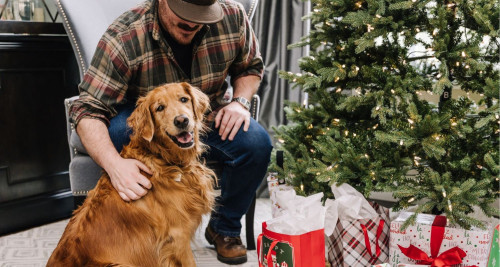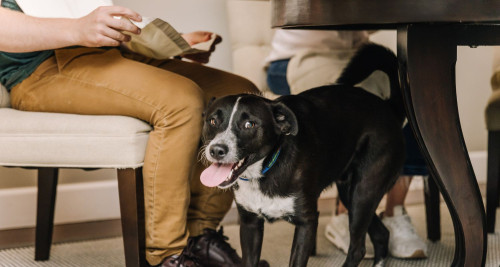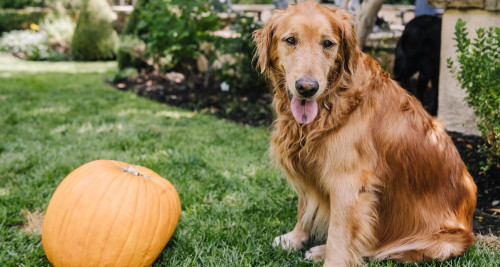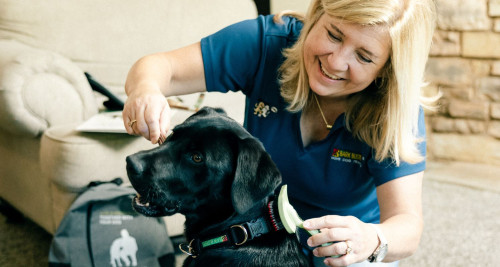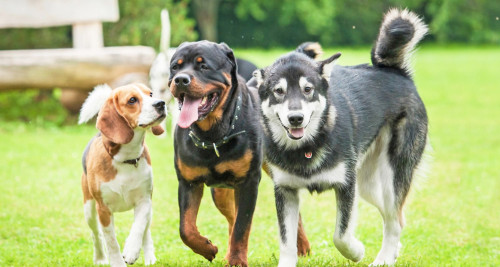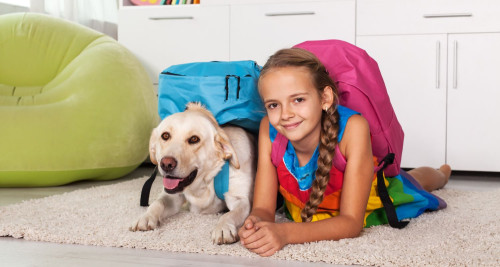Goldendoodle
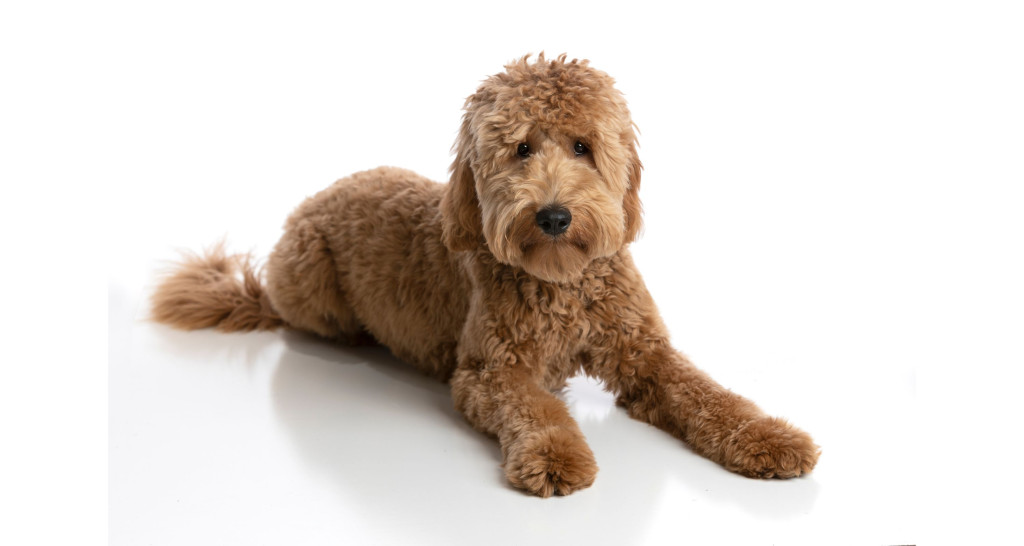
Breed Traits and Characteristics
According to the Daily Paws, here are some breed characteristics you can find in Goldendoodles.
- Height
17-21 inches
- Weight
50-90 pounds
- Life Expectancy
10-15 years
- Coat Type/Length
Curly/Medium
-
100 Affectionate with Family
-
100 Good with Young Children
-
100 Good with Other Dogs
-
100 Trainability Level
-
80 Energy Level
-
40 Barking Level
-
20 Shedding Level
-
20 Drooling Level
History
Known as Golden Poos, Goldie Poos, or Groodles, this breed has a short history and much love for its unique Goldendoodle personality. There is conflicting information on where this breed originated, with some saying Canada or Australia. We do know they became popular in Australia in the 1980s and appeared in North America in the 1990s. As pet owners were looking for a larger dog that was allergy free, a Golden Retriever was bred with a Standard Poodle and instant fame followed!
The original designer breeds came into being when it was discovered that recipients of dogs used as ‘seeing eye’ and ‘service dogs’ were allergic to pet fur, so a dog that does not shed was sought.
Since Goldendoodles are not pure bred and are cross-bred, they are not recognized by the American Kennel Club as a breed of their own. This hybrid dog is recognized by the American Canine Hybrid Club, Designer Dogs Kennel Club, Dog Registry of America, Inc., International Designer Canine Registry and Designer Breed Registry. After seven generations have been bred, the Goldendoodle will become eligible for purebred dog registries.
The Goldendoodle
This month’s medium-sized breed -The Goldendoodle - continues to hold popularity with many dog lovers because of its affectionate nature. Many dog owners are drawn to the Goldendoodle personality, as it combines friendliness, playfulness, and sharp intelligence.
They are referred to as “toy dogs”, “hybrids” or “designer dogs”. Relatively new on the scene, Goldendoodles made their debut in the United States and Australia in the 1990s and have quickly grown in popularity. Why? They are a cross between a Golden Retriever and a Poodle, two well-loved breeds that are adorable and smart.
Golden Retrievers are known as loving, friendly dogs. Poodles are considered to be one of the smartest breeds. No wonder that a cross between these two would be desirable! Additionally, because the poodle is considered hypoallergenic, the Goldendoodle is a great choice for people who are only mildly allergic to dogs.
Bark Busters has recently trained “oodles of doodles”. Before you go head-over-heels for your Goldendoodle and totally spoil him/her, know that they have behavioral issues that come with their breed, naughtiness and stubbornness being two personality traits. You have to remember that your Goldendoodle will have the traits of both the Poodle and the Golden Retriever, both generally stable breeds, but sometimes the mix of the two is a cocktail of rowdiness and willfulness. Nothing that Bark Busters' dog training can’t overcome!
Goldendoodle Breed Facts
Physical Characteristics
Goldendoodles vary in size and physical appearance, depending on whether or not they look more like a Golden Retriever or a Poodle. You will see longer, shaggy-haired versions or a shorter, curlier hair type. When the fur is not cut, it will grow 4 – 8 inches long and can grow to disrupt the vision around a Goldendoodle’s eyes. Therefore, it needs to be clipped regularly so your dog can see! These adorable fur kids come in a large selection of colors -- cream, gold, apricot, chocolate, gray and black.
Standard Goldendoodles weigh 45 – 100 pounds, medium size weigh 30 – 45 pounds, and miniature weigh 15 – 30 pounds (mom or dad being a toy poodle).
When we say that Goldendoodles are “designer dogs”, we mean they are first-generation hybrids. If they are bred from a purebred poodle and a purebred Golden, this is known as “hybrid vigor.” This means you get the best characteristics of both breeds and are thought to be even healthier than their pet parents. However, Goldendoodle health issues can still arise, so regular vet checkups are essential.
Personality & Temperament
Goldendoodles are so popular because they have the easy going, friendly nature of the Golden Retriever and the brains of a Poodle. They are so cute it is hard to resist their enthusiasm. Because they are so social, separation anxiety can be a big issue with this breed. A Goldendoodle's temperament can be:
- Affectionate
- Desire to please
- Kid friendly
- Great for people with mild dog allergies
- Light shedder but requires regular grooming and clipping
- Likes being indoors with people versus isolated outdoors in a kennel
- Highly intelligent
- Gets along well with humans and other pet
- Good dog for first time pet owners
- Both the Retriever and the Poodle are in the top 5 in terms of intelligence. The Poodle is #2, while the Golden Retriever is #4… they are brainiacs!
Capabilities
Goldendoodles are highly empathetic and really want to assist people who need a helping hand … or paw! Their extreme loyalty, gentle nature and quickness in learning make them ideal to be service dogs. They also make excellent therapy and guide dogs and can make wonderful companions for:
- Blind or persons with vision impairment
- People in nursing homes
- Elderly hospice residents
- Hospital patients
Goldendoodle Common Behavioral Issues
Everybody is a friend to a Goldendoodle and they thrive when they are around people. Conversely, they do not like to be alone for long periods and will become destructive if they aren’t getting the attention they need. Goldendoodles can have a hard time with separation anxiety.
If your Goldendoodle is bored, you’ll know it because the destruction begins. This is when dogs tend to misbehave the most.
It is important not to spoil your Goldendoodle too much to the point where you accept misbehaviors. It’s hard when they look like adorable teddy bears, but there is a major difference between loving and spoiling your dog. They do not do well with aggressive, harsh training because they are very sensitive. Goldendoodles respond best to positive reinforcement. They live for belly rubs and sloppy kisses. Bark Busters does not believe in negative reinforcement because too often, aggression breeds aggression.
Goldendoodle issues can include:
- Aggression
- Boredom
- Destructive behaviors like mouthing, nipping, chewing
- Difficulty in house training
- Hyperactive
- Jumping
- Not coming when called
- Play biting
Always choose a reputable breeder and ask for references. Because Goldendoodles are “designer dogs,” they can often cost a pretty penny. That’s why we suggest looking at rescues, animal welfare shelters and the local Humane Society or RSPCA. These dogs are tested for temperament and soundness.
If you want a “miniature Goldendoodle”, make sure one of the parents is a toy poodle, or you will have a much bigger dog than you expected.
Remember your dog is only as good as you are as a role model. As a medium dog expected to live 15 years or more, it’s important you provide your Goldendoodle not only with the basics, but you meet all his/her needs mentally, physically and psychologically.
Goldendoodles are generally indoor dogs who like to be near their family. If you want an independent outdoor dog (like a German Shepherd), a Goldendoodle is not for you.
Goldendoodles love human companionship and bond very strongly with their owners. Goldendoodles will find ways to entertain themselves, so it is important to provide them with enough chewing toys and good training before leaving them for any amount of time.
Your Goldendoodle’s energy is boundless. You and your kids must provide plenty of time to play to keep him out of trouble. If you’re not going to be around, it’s important to give your Goldendoodle something to do like playing with a Kong or an interactive toy. If you’re out and about, leave the radio or TV tuned to Animal Planet or your dog will feel isolated.
Because Goldendoodles are so active, you must be very wary of them running away.
Training Your Goldendoodle
If you have a Goldendoodle, you have your hands full. They have boundless energy and a hard time focusing. They can be extremely naughty and mischievous and well-known for chewing, nipping and mouthing everything in sight! And door manners? They've never heard of them.
Because Goldendoodle behavior problems can quickly develop without proper guidance, early training is critical! Training a Goldendoodle should begin as soon as you bring them home, ideally as a puppy. They respond well to positive reinforcement methods and need a strong, confident leader.
Dogs learn to communicate with others when they are first born, mimicking their mom and siblings. This is knows as the "pack mentality." Suddenly, you adopt them into your home and start speaking a language they don't understand. Dogs don't converse with each other with prongs, shock collars, or even treats. That's why our Bark Busters trainers teach pet owners how to communicate with dogs the natural way - with voice tones and body language. We call it "speaking dog."
Without training, your dog will quickly learn the pack's pecking order and look for the weak links. They will constantly question your authority and attempt to move themselves higher up in the pack. Establishing yourself as the leader through consistent Goldendoodle training is your key to success.
Because of their high energy, Goldendoodles need a lot of mental and physical stimulation. Multiple walks/day and some interactive toys will help. Goldendoodles will shadow you everywhere you go and don’t like to be left alone. If you’re going to work or will be gone for the day, make sure you leave them with things to do or their destructive behaviors will kick in out of boredom.
One word of advice: Although great family companions, Goldendoodles are not good watchdogs so don’t put them in a guarding situation.
If you are struggling with your enthusiastic Goldendoodle's behavior, you do not have to do it alone! Bark Busters trainers specialize in training a wide variety of challenging dog breeds, Goldendoodles included. If you are frustrated and heartbroken or welcoming a new puppy, reach out to us today. We're here to help you achieve a well-mannered, happy companion and ease the heartache of communication and behavior barriers between you and your dog.
Find your trainer today and find your dog’s personality and behavior begin to shine!
Connect with Us!
Need help training your Goldendoodle? Call 1-877-500-BARK (2275)or enter your zip code.
Training and Caring for Goldendoodles
Goldendoodles, a cross between Golden Retrievers and Poodles, are beloved for their intelligence, friendliness, and energetic personalities. These traits make them excellent companions for active families. While their enthusiasm is one of their most endearing qualities, it can also lead to common challenges like jumping on people, pulling on the leash, or not coming when called.
Bark Busters trainers work with families to address these behaviors and teach Goldendoodles proper manners and basic obedience. Most Goldendoodles respond quickly to training because they are eager to please and enjoy learning. With consistent guidance, they grow into well-behaved, happy family members—and many even excel as therapy dogs once their puppy energy settles.
It’s important to remember that Goldendoodles, like many larger breeds, mature physically faster than mentally. Full maturity often comes around two years of age or later. Starting training early and integrating education into daily routines helps set the foundation for lifelong good behavior. Bark Busters trainers create personalized training plans, teaching dogs to live harmoniously with their families while strengthening the human-dog bond. Mental stimulation and regular exercise are key for keeping these active, high-energy dogs calm and focused.
Whether you are welcoming a puppy or working with an adult Goldendoodle, Bark Busters trainers provide expert guidance to help your dog reach its full potential. Proper training ensures your Goldendoodle becomes a loyal, obedient, and joyful family companion. Choosing a reputable breeder and getting professional training early will help set the stage for a well-adjusted, happy dog that fits seamlessly into your home and lifestyle.
Goldendoodle Health
Common Injuries and Illnesses
Your Goldendoodle’s health concerns will change over the course of their life. A puppy might be more prone to eating something they shouldn’t, a 2-year-old Doodle may be more likely to show signs of allergies, and a senior Goldendoodle is far more likely to develop a mass as they age. Goldendoodles also have personality and physical traits that may make them more prone to certain conditions. This breed can be exceptionally playful, curious, and rowdy, and they can get into things they shouldn’t and injure themselves along the way.
At any stage of life, here are some of the most common injuries and illnesses you should be aware of when bringing home a Doodle:
- Bloat
- Addison’s disease
- Heart disease
- Allergies
- Eye problems
- Skin conditions
- Hip and elbow dysplasia
- Ear infections
If you are ever concerned about your dog’s health, your local veterinarian is a great resource—no matter how small the question.
Genetic Health Concerns
Despite being a hybrid of two breeds, the Goldendoodle has its fair share of hereditary based issues inherited from the Poodle and Golden Retriever. These include things like Addison’s Disease and hip dysplasia. Most reputable breeders now have their breeding stock checked and scored for these hereditary ailments by a veterinarian. You can request proof that the puppy you are purchasing comes from parents who have been checked for these issues.
Because many other health issues are also hereditary, you should do some research on the ancestry of your puppy and any health issues of that breed.
Tips for Every Dog Owner
Hear from Bark Busters Clients Who Have a Goldendoodle
Transform Your Goldendoodle's Behavior: Fill Out Our Form and Discover the Value of Expert Training!
Quickly confirm your zip code and complete this short form, and we’ll contact you by email or phone within 24 hours to discuss your pet’s training. Avoid the hassle and questionable group classes by opting for customized in-home dog training near you.
- 99.7% 4 or 5 stars 99.7% rate their experience with Bark Busters as 4 or 5 out of 5 stars.
- 99.6% Would Recommend 99.6% would recommend Bark Busters to their friends and neighbors.
- 99.5% Dog Responded 99.5% think their dog responded well to the training.
Need Dog Training Assistance with Your Goldendoodle? Find Your Local Trainer Now!
CALL TODAY 1-877-500-BARK (2275)
